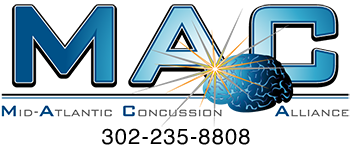
Brain SPECT Imaging is a state-of-the-art brain mapping tool approved by the American College of Radiology to determine the location and extent of structural injuries using 3D metabolic images of the brain. Mid-Atlantic Concussion Alliance, through a unique partnership with Amen Clinics, can provide Brain SPECT Scan imaging to our concussion and traumatic brain injury (TBI) patients.
How Are Brain SPECT Scans Used in Concussion and TBI Treatment?
Amen Clinics’ Brain SPECT Scans can determine where the injury is. SPECT stands for “single photon emission computed tomography,” which is a three-dimensional picture of organs, such as the brain. Using both a computer tomography (CT) and a radioactive tracer (typically Tc-99), special cameras then detect the gamma rays from the tracer and a 3D image is configured of the brain. Amen Clinics has built the world’s largest database of Brain SPECT Scans, with over 200,000 done over the past 30 years. They also have over 70 peer-reviewed studies published about their scientific research on SPECT imaging.
This Is How SPECT Scans Work
In addition to the extensive research supporting SPECT Scan’s use for mental health diagnosis and treatment, it has been accepted by the American College of Radiology as a useful tool in diagnosing and treating traumatic brain injuries (TBIs), like concussions. In their extensive research with Brain SPECT Scans for diagnosis and treatment for mental health, the medical research staff at the Amen Centers realized that asymmetry of overactive or underactive brain metabolism was the hallmark of TBI’s. When there is no associated bleeding, the microscopic changes to the brain (known as axonal shearing) from a TBI are invisible on CT Scans and MRIs, which means the brain injury may be missed or misdiagnosed. With a functional test like a Brain SPECT Scan, those microscopic changes are revealed.
Brain SPECT Scans are also approved by the Canadian Nuclear Medicine Board and the European Union of Medical Specialists for uses in TBI diagnosis and treatment.
Metabolism, TBI and Brain SPECT Scans: Providing Proof of “Invisible Injuries”

Comparison Brain SPECT Scans
Brain SPECT Scans allow doctors to see how blood flows throughout the brain. A lack of blood flow indicates injured areas. We can compare blood flow (metabolism) at rest and with concentration for a detailed picture of a patient’s injury and healing process.
One of the most frustrating things for post-concussion syndrome (PCS) and other TBI sufferers is that their “invisible injuries” are not taken seriously or believed by those around them. They are told, “You look fine,” when they know they are still dealing with symptoms. This often has devastating consequences—lost employment, strained familial relationships, isolation, and worse. With SPECT Scans, we can offer scientifically backed data to prove brain injuries exist and track patient progress, even years after the initial injury.
Brain SPECT Scans Can Document a TBI, in 3D
The American College of Radiology has suggested that in certain TBI situations ‘‘SPECT studies may reveal focal areas of hypoperfusion that are discordant with findings of MRI or CT. On the basis of these results, some investigators suggest that these functional imaging techniques may explain or predict postinjury neuropsychologic and cognitive deficits that are not explained by anatomic abnormalities detected by MRI or CT . Furthermore, focal lesions demonstrated by SPECT offer objective evidence of organic injury in patients whose neuroimaging studies are otherwise normal.’’
A 2022 study from University of Toronto shows a 97% correlation with a positive BrainScope-EEG and a positive Brain SPECT Scan, which has proven existence and severity of a TBI with enough authority to be considered proof of injury in legal presidings nationwide. We have been finding similar levels of accuracy in validating patient diagnosis with our MAC Alliance patients as well.
How Accurate and Reliable Is Brain SPECT Scan imaging for TBIs and Conncussions?
Very. In fact, SPECT Scans of the brain are being used as evidence by expert witnesses—as well as Daubert challenges to expert witnesses—in nationwide in legal settings.
See More Research Studies on Brain SPECT Scans
Make an Appointment
Please contact us about scheduling a SPECT Scan. MAC Alliance is a growing network of certified medical practitioners and athletic trainer affiliates. We also utilize additional brain monitoring tools for concussion diagnosis and treatment that include: BrainScope One EEG technology, ImPACT and Creyos Health neurocognitive testing, RightEye and EyeGuide infrared eye-tracking technology, and Sway Balance System mobile neurological assessments.
Concussion testing can be promptly obtained at one of our partner locations in Delaware, Maryland, New Jersey, New York, Pennsylvania, and Virginia.








